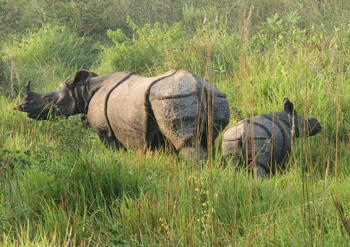Relocation of rhinos, wild buffaloes delayed
Kathmandu, October 23
Although the government had decided to relocate 30 rhinos, 30 wild water buffaloes (arna), and 35 swamp deer to protected areas by 2018, no preparation for this has been made as yet, besides translocating five one-horned rhinos and five swamp deer in the fiscal 2072/73.
The government had made a decision to relocate 25 rhinos to Bardiya National Park and five to Shuklaphanta Wildlife Reserve from Chitwan National Park, 30 wild water buffaloes to CNP from Koshi Tappu Wildlife Reserve, and 25 swamp deer to BNP and 15 to CNP from Shuklaphanta Wildlife Reserve.
Government authorities and conservation partners have succeeded in translocating five rhinos in March and five swamp deer in June this year, but no other development has taken place. The National Park and Wildlife Conservation Department admitted the process has delayed due to technical difficulties.
“We have not built the right infrastructure to house water buffaloes in CNP yet,” Gopal Prakash Bhattarai, acting director general at the department, told The Himalayan Times, “We tried to finish the translocation process earlier, but technical issues have created hurdles.”
Bhattarai said authorities had invested much in capturing swamp deer for translocation from SWR to BNP earlier. Bhattarai said that the government had made the decision to relocate rhinos, wild water buffaloes, and swamp deer to revive their population in their original habitats.
The DNPWC informed that capturing and shifting the animals requires huge investment.
During the first rhino translocation this year, 33 elephants and a team of about 250 people led by the Ministry of Forest and Soil Conservation with the support of WWF Nepal, National Trust for Nature Conservation, Nepal Army, and local communities were involved.
The translocation was funded by WWF’s AREAS Program, WWF US, USAID, and US Fish and Wildlife Service.
The rhino, an adult male, was first tracked and sedated in Chitwan National Park on March 1. It was then fitted with a satellite collar and loaded on to a specially designed truck to transport it safely to Babai Valley in Bardia National Park where it was released on March 2.






